execut / yii2-cms
Yii2 eXeCUT CMS
Installs: 338
Dependents: 1
Suggesters: 0
Security: 0
Stars: 10
Watchers: 2
Forks: 2
Open Issues: 0
Type:yii2-extension
pkg:composer/execut/yii2-cms
Requires
- dev-master
- 0.10.14
- 0.10.13
- 0.10.12
- 0.10.11
- 0.10.10
- 0.10.9
- 0.10.8
- 0.10.7
- 0.10.6
- 0.10.5
- 0.10.4
- 0.10.3
- 0.10.2
- 0.10.1
- 0.10.0
- 0.9.1
- 0.9.0
- 0.8.0
- 0.7.11
- 0.7.10
- 0.7.9
- 0.7.8
- 0.7.7
- 0.7.6
- 0.7.5
- 0.7.4
- 0.7.3
- 0.7.2
- 0.7.1
- 0.7.0
- 0.6.2
- 0.6.1
- 0.6.0
- 0.5.0
- 0.4.3
- 0.4.2
- 0.4.1
- 0.4.0
- 0.3.0
- 0.2.4
- 0.2.3
- 0.2.2
- 0.2.1
- 0.2.0
- 0.1.1
- 0.1.0
This package is auto-updated.
Last update: 2025-12-10 17:17:19 UTC
README
Warning! Beta version. Please add tasks here if you find errors. I will try to fix them quickly
CMS, based on Yii2 modular system and extension yii2-crud-fields. All system modules are standalone Yii2 modules and can be used separately from CMS.
List of system features and modules:
| Feature | Module | Extended by modules | Development status |
|---|---|---|---|
| Aliases for urls of records like page and logging their changes | execut/yii2-alias | yii2-files, yii2-images, yii2-news, yii2-pages, yii2-shops | |
| Goods | execut/yii2-goods | yii2-files, yii2-pages | |
| Files | execut/yii2-files | yii2-alias, yii2-goods, yii2-images, yii2-pages, yii2-seo | |
| Images | execut/yii2-images | yii2-files | |
| Menus | execut/yii2-menu | yii2-pages | |
| Site pages content | execut/yii2-pages | yii2-alias, yii2-files, yii2-goods, yii2-menu, yii2-seo, yii2-sitemap, yii2-settings | |
| SEO metadata | execut/yii2-seo | yii2-files, yii2-pages | |
| Site settings | execut/yii2-settings | yii2-rbac | |
| Robots.txt generation | execut/yii2-robots-txt | - | |
| Sitemap generation | execut/yii2-sitemap | yii2-pages, yii2-news, yii2-shops | In progress |
| Site settings | execut/yii2-settings | yii2-pages, yii2-news, yii2-shops | |
| Information pages about chain of stores | execut/yii2-shops | yii2-seo | In progress |
| Blog, articles and news | execut/yii2-news | yii2-seo | In progress |
| Users manager | execut/yii2-users | yii2-rbac | In progress |
| RBAC manager | execut/yii2-rbac | yii2-users | In progress |
| Feedback | execut/yii2-feedback | yii2-users, yii2-antispam, yii2-settings | In progress |
| Antispam protection | execut/yii2-antispam | - | In progress |
| Orders | execut/yii2-orders | yii2-goods | New |
| Basket | execut/yii2-basket | yii2-orders, yii2-antispam | New |
Supported databases:
- PostgreSQL
- MySQL
Installation
The easiest installation method is to install over of a yiisoft/yii2-app-advanced based application. To install Yii2 CMS into your project, you need to take only three steps:
- Connect the CMS package
- If you have an existing project, you can connect the package by running the command
composer require execut/yii2-cms. - If you are going to deploy Yii2 CMS on a new application, you can install a prepared project-template execut/yii2-cms-advanced-template. Installation instructions here.
- If you have an existing project, you can connect the package by running the command
- Apply migrations
./yii migrate/up --interactive 0 - Create an admin user with the command
./yii cms/users/create-admin admin password email@example.com, where: admin - login, password - password, email@example.com - user email
Usage
If you used standard layers layouts/main.php in the in backend and frontend applications, then after installing the CMS, they should be redefined. All CMS content is displayed in these layers. If this did not happen, then you are using non-standard layers, and the CMS did not reassign them, thinking that you want to use your own. To use custom layer, you need to display all the elements for the CMS to work in it in the likeness of these two: frontend.php and backend.php.
The backend application should start displaying sections and a menu should appear:

In this case, the frontend application should show pages along with the menu:

